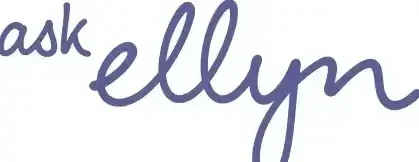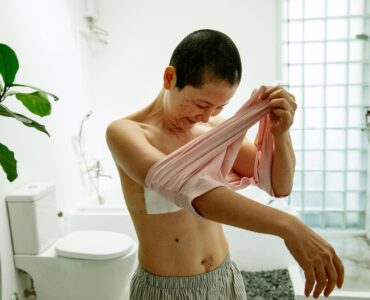As part of my treatment for breast cancer I had 15 rounds of radiation, administered daily. It was the third and final leg of my cancer treatment plan, which also included a double mastectomy surgery and 12 weeks of chemotherapy.
I saw a line recently that referred to radiation as the crumb catcher of cancer treatment. It is there to kill off any errant cells that may have escaped the surgeon’s knife or that the chemo may not have killed. I had microscopic cancer that crept into my sentinal lymph nodes, so they would not only radiate my chest where the the tumors originated in my breast, but also my left underarm where the offending lymph nodes were evicted.
There’s so much mystery that surrounds these procedures. And quite honestly why would anyone need to know the particulars about radiation therapy if it wasn’t in the cards for them? But then you get diagnosed and suddenly you need to have all the answers and desperately want to know what the experience will be like. So here goes…
Radiation preparation
My radiation therapy took place at our local cancer centre little more than a month after I finished chemotherapy.
Ten days before my sessions began I arrived at the cancer centre for a radiation planning session. Think of it like a dress rehearsal of sorts. Radiation, especially when you are navigating around vital chest organs like your lungs and heart is an exercise in precision. This is not crude guesswork. They need to have a precise mapping of your anatomy to know where to aim the beams. During this dry run technologists take a CT scan of your chest, and use what felt to me like a beanbag to build a custom mold of your chest with arms extended over your head. They also tattooed a series of wee green dots to map out the perimeters for the radiation scan. These would be used in every treatment to allow the machines to triangulate and coordinate.
I remember asking my radiation oncologist Dr K how they could avoid damaging my heart given my cancer was on my left side and radiation treatment would be. He explained that the heart is heavy, like a water balloon, and when you lay on your back, it falls back toward your spine. As an additional safeguard, those who have radiation on their left side are led through a breath hold, which provides a little extra clearance for the radiation beams.
I was also told not to use any creams or lotions in advance of sessions. They want you “au natural” to ensure there is no interference and that they can properly monitor your skin’s response.
Radiation treatment
My first radiation treatment ironically took place on October 31, Halloween. To celebrate the occasion I wore all black to my appointment and a skeleton T-shirt. My entire team of techs that day were all in costume, which certainly broke the ice. After checking in at the cancer centre I was sent to my “zone” and changed out of my t shirt and into a hospital gown, prepped for action.
I don’t think I am the only one but found the entire process fascinating. You are positioned very carefully on the bed, snuggled into your custom mold (I asked if I could keep it as a souvenir but no dice). The techs jog the bed up and down and over to get the machine calibrated just so. There’s huge screens overhead and numbers are being called out and repeated to ensure everything and you are properly positioned. At one point they pull out what looked like a grade school ruler to measure the distance between my tattoo dots which stuck me as very funny given the multi-million dollar machine set up in the room. Then everybody bolts for cover and you are asked to “take a breath and hold” and the laser beams fly. You feel nothing. The process is repeated several times. The longest near the end, focused on (I think) my lymph nodes, I called my swimming pool breath hold. I used to mentally dive into the pool and swim from one end to the other.
I should add for those who might freak out about holding your breath, the machine immediately stops if you stop. So there are safeguards in place.
All told, you are in and out in about 30 minutes. Sometimes a bit longer if they do supplementary imaging to see if there’s been any swelling that might alter their precise calibrations. But at most 45 minutes. My girlfriend who would drive me got to the point where she didn’t even try to part. She’d just lap the block a few times and cruise in to pick me up.
Radiation side effects
This is very much an individual thing. Like chemo, there is a long list of potential side effects from radiation. How you react is something that has to play out.
I experienced none of the fatigue that some folks complain about. I found my energy levels to be consistently good, and worked out daily on my regular routine throughout.
I am not fair and my skin easily tans in the summertime. So my skin tolerated the radiation quite well. Every week I would see a nurse who would examine me to see how I was faring. Near the end of my schedule, my left side developed what looked like dots on the skin, a form of mild radiation dermatitis. This was the signal to the nurses to have me begin applying Glaxal a hypoallergenic skin creme to the affected area. My skin after that point did pink up more, like a sunburn. But I have to say, it was not as painful as the real thing.
Radiation effects continue after the treatments concluded, so I was warned that my skin might worsen before it improved. True to form, I did have some of my skin in my underarm split causing some soreness. Fortunately, a couple of days in a loose top and some topical Polysporin antibiotic ointment resolved things quickly.
I do to this day, a year and a half later after treatment ended, I still have a brown tanned area on my left side spanning from the bottom of my ribs to my sternum and into my left armpit. It has faded somewhat, but likely will always be there. It’s the souvenir I didn’t ask for or quite expect when I began my radiation therapy.
And the wee green tattoos?
Yep, they are still there too.




